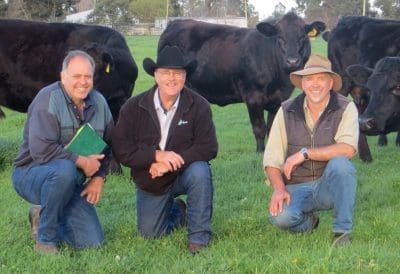In one of his recent columns, genetics editor Al Rayner wrote about the broadening options open to bull breeders in performance recording, with some Australian breeds in recent times moving from BreedPlan to the International Genetics Solutions (IGS) program. In this article, IGS director of science and education, Dr Jackie Atkins, offers her perspective about the merits of the IGS system and where it is heading
EARLY in life, we are taught to share – share with our siblings, share with our classmates and share with our neighbours.
The fact that we have to learn this behaviour is telling – it’s not instinctive. It is human nature to protect what is ‘ours’, and become territorial to ensure we have what we need to survive and thrive.

WA Simmental breeder Mike Introvigne, Willie Altenburg, Altenburg Simmental Ranch, Colorado USA (Bonnydale alliance stud) & Rob Introvigne. in 2018 Bonnydale genomically profiled its entire stud herd with the American Simmental Association utilising IGS, and has continued to genomically profile every calf since.
However we have seen how we all can do better by working together, sharing resources, and maybe most importantly, sharing ideas. This philosophy of comradery and collaboration is at the heart of the International Genetic Solutions (IGS).
IGS aims to serve the beef industry by providing resources for genetic improvement using the best technology available and unprecedented collaboration. The IGS collaboration now has 20 million animals and almost 300,000 genotypes from 20 different organisations on its records.
Not only is it the largest beef cattle database, but it also has a huge amount of connectivity among the different organisations. Nearly one third of the progeny records in the IGS evaluation have siblings in a separate database, and multiple sires have progeny in as many as 12 databases.
If each of these databases was an island with an isolated evaluation, we could all breathe a little easier because the evaluation would be much simpler. But, it wouldn’t be better; it wouldn’t be as accurate; and it wouldn’t give the best genetic predictions of the animals in the evaluation.
Instead, the IGS model has chosen the harder path. It is complex to have one evaluation with 20 different data sources. It is challenging to have a multi-breed genetic evaluation and to account for different breed effects and heterosis.
But, at the end of the day we want to provide the BEST possible genetic predictions not only to seedstock breeders, but for anyone using EPDs or (BreedPlan) EBVs to select their future genetics.
Territorial behaviour
The IGS model also sets aside the territorial toddler behaviours often seen in breed associations and societies. Instead of guarding our data, our material, our resources to be used only to help our association improve, the IGS system opens the doors of communication among all the IGS partners to offer better resources to all the members and ultimately the beef industry.
We all benefit from working together and sharing various perspectives from different breeds of cattle, different breed associations, and different countries, but with the common goal of beef cattle genetic improvement.
Beyond making the best possible genetic predictors, the staff from the various IGS partners learn from each other, share educational material, collaborate on different research projects, and work through various challenges most of us have faced alone, but can get through better together.
Collaborations in Australia, Canada
While IGS has its roots in the US, it has several partners in Canada and is growing similar collaborations in Australia.
In 2019, the Shorthorn Beef Association joined IGS and recently the Australian Simmental Association jumped on board. Additionally some Australian seedstock breeders are receiving IGS genetic predictions through membership with the American Simmental Association.
The Australian shareholders in IGS have added a new scope to the IGS partnership and helped to tailor the IGS evaluation to fit Australian beef systems. For instance, IGS recently made changes to both the ultrasound age window and the eye muscle area (rib-eye) conversion to better match the Australian carcase trait norms.
The IGS group is excited about the future collaborations working with Shorthorn Beef, Australian Simmental Association, and additional Australian beef industry enthusiasts. While the future is unknown to all of us, it is certain to improve by working together towards a common good.



HAVE YOUR SAY